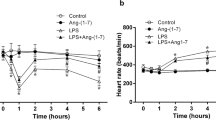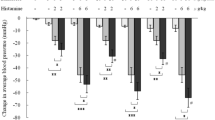Summary
The aim of the study was to evaluate 1) whether the ability of leucocytes to produce oxygen radicals was increased by ischemia and 2) if ibuprofen pretreatment could influence leucocyte oxygen radical production, hemodynamic function, and myocardial oxygen consumption during acute ischemic myocardial failure. We studied two groups of anesthetized dogs (control and ibuprofen-treated), both subjected to coronary embolization with polystyrene microspheres (diameter 50 μm). The embolization procedure was ended when left-ventricular end-diastolic pressure in both groups exceeded 20 mm Hg. Before and after induction of ischemia leucocytes were isolated and stimulated with opsonized zymosan, and oxygen radical production was measured using the luminol-dependent chemiluminescence technique. Significant increase occurred in oxygen radical production (from 10.9±2.2 to 16.3±2.3·105 counts·106 cells−1·60 min−1) 90 min after failure in the control group, whereas in ibuprofen-pretreated dogs oxygen radical production was unchanged. Hemodynamic registrations and myocardial oxygen consumption 90 min after failure were, however, not significantly different in control dogs and dogs pretreated with ibuprofen. Thus, in the present study, within the first 90 min of acute ischemic failure, a decrease in the ability of leucocytes to produce oxygen radicals was not related to significant changes in myocardial function.
Similar content being viewed by others
References
Allen RC, Stjernholm RL, Steele RH (1972) Evidence for the generation of an electronic excitation state(s) in human polymorphonuclear leucocytes and its participation in bactericidal activity. Biochem Biophys Res Commun 47:679–684
Aukland K, Bower BF, Berliner RW (1983) Measurement of local blood flow with hydrogen gas. Circ Res 14:164–187
Bender JG, McPhail LC, Epps DEV (1983) Exposure of human neutrophils to chemotactic factors potentiates activation of the respiratory burst enzyme. J Immunol 130:2316–2323
Cohen MV (1989) Free radicals in ischemic and reperfusion myocardial injury: is this the time for clinical trials? Ann Int Med 111:918–931
Cross AR (1990) Inhibitors of the leucocyte superoxide generating oxidase: mechanisms of action and methods for their elucidation. Free Radical Biol Med 8:71–93
Engler RL, Dahlgren MD, Morris DD, Peterson MA, Schmid-Schönbein GW (1986) Role of leucocytes in response to acute myocardial ischemia and reflow in dogs. Am J Physiol 251:H314-H322
Ferrari R, Ceconi C, Curello S, Cargnoni A, Pasini E, De Giuli F, Albertini A (1991) Role of oxygen free radicals in ischemic and reperfused myocardium. Am J Clin Nutr 53:215S-222S
Guthrie LA, McPhail LC, Henson PM, Johnston RB (1984) Priming of neutrophils for enhanced release of oxygen metabolites by bacterial lipopolysaccharide. J Exp Med 160:1656–1671
Ito BR, Roth DM, Chenoweth DE, Lefer AM, Engler RL (1989) Thromboxane is produced in response to intracoronary infusions of complement C5a in pigs. Cyclooxygenase blockade does not reduce the myocardial ischemia and leucocyte accumulation. Circ Res 65:1220–1232
Jolly SR, Kane WJ, Bailie MB, Abrams GD, Lucchesi BR (1984) Canine myocardial reperfusion injury. Its reduction by the combined administration of superoxide dismutase and catalase. Circ Res 54:277–285
Jugdutt BI, Hutchins GM, Bulkley BH, Becker LC (1980) Salvage of ischemic myocardium by ibuprofen during infarction in the conscious dog. Am J Cardiol 46:74–82
Kuzuya T, Hoshida S, Nishida M, Kim Y, Fuji H, Kitabatake A, Kamada T, Tada M (1989) Role of free radicals and neutrophils in canine myocardial reperfusion injury: myocardial salvage by a novel free radical scavenger, 2-octadecylascorbic acid. Cardiovasc Res 23:323–330
Lefer AM, Polansky EW (1979) Beneficial effects of ibuprofen in acute myocardial infarction. Cardiology 64:265–279
Lindal S, Smiseth OA, Mjøs OD, Myklebust R, Jørgensen L (1986) Reversible and irreversible changes in the dog heart during acute left ventricular failure due to experimental multifocal ischaemia. Acta Path Microbiol Immunol Scand, Sect A 94:177–186
Mullane KM, Read N, Salmon JA, Moncada S (1984) Role of leucocytes in acute myocardial infarction in anesthetized dogs: relationships to myocardial salvage by anti-inflammatory drugs. J Pharmacol Exp Ther 228:510–522
Minta JO, Williams MD (1985) Some nonsteroidal antiinflammatory drugs inhibit the generation of superoxide anions by activated polymorphs by blocking ligand-receptor interactions. J Rheumatol 12:751–757
Nathan CF (1987) Neutrophil activation on biological surfaces. Massive secretion of hydrogen peroxide in response to products of macrophages and lymphocytes. J Clin Invest 80:1550–1560
Nicols WW, Mehta JL, Donnelly WH, Lawson D, Thompson L, ter Riet M (1988) Reduction in coronary vasodilatator reserve following coronary occlusion and reperfusion in anesthetized dog: role of endothelium-derived relaxing factor, myocardial neutrophils infiltration and prostaglandins. J Mol Cell Cardiol 20:943–954
Ohlstein EH, Nicols AJ (1989) Rabbit mononuclear neutrophils elicit endothelium-dependent contraction in vascular smooth muscle. Circ Res 65:917–924
Romson JL, Hook BG, Kunkel SL, Abrams GD, Schork MA, Lucchesi BR (1983) Reduction of the extent of ischemic myocardial injury by neutrophil depletion in the dog. Circulation 67:1016–1023
Romson JL, Bush LR, Haack DW, Lucchesi BR (1980). The beneficial effect of oral ibuprofen on coronary artery thrombosis and myocardial ischemia in the conscious dog. J Pharmacol Exp Ther 215:271–278
Romson JL, Hook BG, Rigot VH, Schork MA, Swanson DP, Lucchesi BR (1982) The effect of ibuprofen on accumulation of indium-111-labeled platelets and leucocytes in experimental myocardial infarction. Circulation 5:1002–1011
Rossen RD, Michael LH, Kagiyama A, Savage HE, Hanson G, Reisberg MA, Moake JN, Kim SH, Self D, Weakley S, Giannini E, Entman ML (1988) Mechanism of complement activation after coronary artery occlusion: evidence that myocardial ischemia in dogs causes release of constituents of myocardial subcellular origin that complex with human C1q in vivo. Circ Res 62:572–584
Smiseth OA, Mjøs OD (1982) A reproducible and stable model of acute ischaemic left ventricular failure in dogs. Clin Phys 2:225–239
Sommers HM, Jennings RB (1964) Experimental acute myocardial infarction. Lab Invest 13:1491–1503
Snedecor GW, Cochran WG, (1973) Statistical Methods. Iowa State University Press, pp 234–235
Weiss SL, LoBuglio AF (1982) Phagocyte-generated oxygen metabolites and cellular injury. Lab Invest 47:412–425
Ytrehus K, Myklebust R, Mjøs OD (1986) Influence of oxygen radicals generated by xanthine oxidase in the isolated perfused rat heart. Cardiovasc Res 20:597–603
Ytrehus K, Myklebust R, Olsen R, Mjøs OD (1987) Ultrastructural changes induced in the isolated rat heart by enzymatically generated oxygen radicals. J Mol Cell Cardiol 19:379–389
Author information
Authors and Affiliations
Rights and permissions
About this article
Cite this article
Ytrehus, K., Semb, A.G. & Myhre, E.S.P. Ibuprofen abolishes the increase in leucocyte chemiluminescence observed during ischemic myocardial failure, but fails to improve hemodynamic function. Basic Res Cardiol 87, 385–392 (1992). https://doi.org/10.1007/BF00796523
Received:
Accepted:
Issue Date:
DOI: https://doi.org/10.1007/BF00796523




